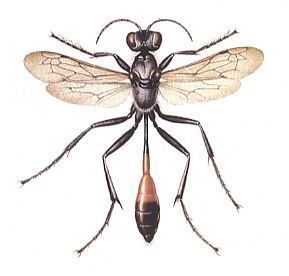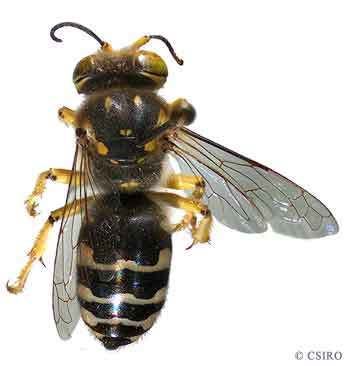Rank Family | Scientific name Sphecidae Higher classification Apoidea | |
Lower classifications Sceliphron, Beewolf, Black and yellow m, Bembix, Cerceris | ||
Thread waisted wasp sphecidae
The Sphecidae are a cosmopolitan family of parasitoidal wasps that includes sand wasps, mud daubers, and other thread-waisted wasps.
Contents
- Thread waisted wasp sphecidae
- Great golden digger wasp sphecidae sphex ichneumoneus grooming
- Biology
- Phylogeny
- Family Sphecidae sensu stricto
- Family Crabronidae
- References

The name Sphecidae was formerly given to a much larger grouping of wasps. This was found to be paraphyletic, so most of the old subfamilies have been moved to the Crabronidae.

Great golden digger wasp sphecidae sphex ichneumoneus grooming
Biology

The biology of the Sphecidae, even under the restricted definition, is still fairly diverse; some sceliphrines even display rudimentary forms of sociality, and some sphecines rear multiple larvae in a single large brood cell. Many nest in pre-existing cavities, or dig simple burrows in the soil, but some species construct free-standing nests of mud and even (in one genus) resin. All are predatory and parasitoidal, but the type of prey ranges from spiders to various dictyopterans, orthopteroids and larvae of either Lepidoptera or other Hymenoptera; the vast majority practice mass provisioning, providing all the prey items prior to laying the egg.
Phylogeny

This cladogram is based on Debevec et al. 2012, which used molecular phylogeny to demonstrate that the bees (Anthophila) arose from deep within the Crabronidae, which is therefore paraphyletic. The Heterogynaidae are also broken up. The small subfamily Mellininae was not included in their analysis.
Family Sphecidae (sensu stricto)

The old digger wasp family Sphecidae (sensu lato) was paraphyletic and has been broken up. Only the following subfamilies remain in the new family Sphecidae (sensu stricto) which is (2014) presumed to be a clade.
Subfamily Ammophilinae
Subfamily Chloriontinae
Subfamily Sceliphrinae
Subfamily Sphecinae
Both of the traditional definitions of the Sphecidae (the conservative one, where all the sphecoid wasps other than ampulicids and heterogynaids were in a single large family, and the more refined one, where the seven large sphecid subfamilies were each elevated to family rank) have recently been shown to be paraphyletic, and the most recent classification is closer to the conservative scheme; the families Heterogynaidae and Ampulicidae are the sister taxa to what are now two families (instead of one), the Sphecidae and Crabronidae. Thus, the bulk of the sphecoid wasps are now placed in Crabronidae, and the Sphecidae per se are much more restricted in concept, equivalent to what used to be the subfamily Sphecinae.
Family Crabronidae
All the other digger wasp taxa that were formerly included in Sphecidae (sensu lato) are now placed in the family Crabronidae, which is however itself paraphyletic.
